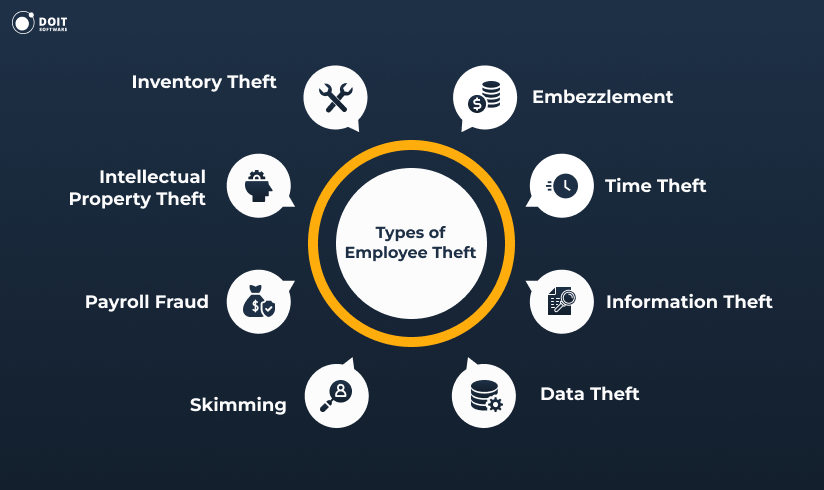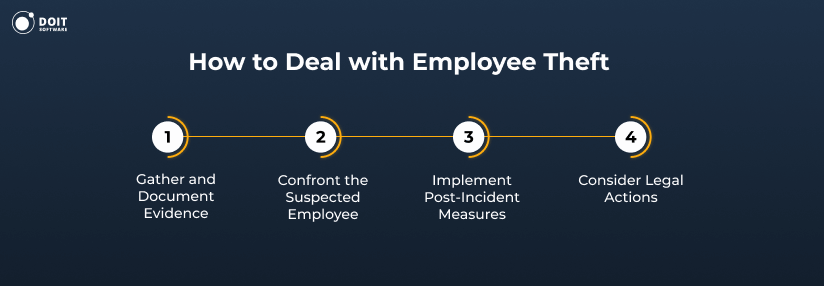Employee theft, the act of stealing from an employer, is more prevalent than most business owners realize. A shocking statistic reveals that 75% of employees have stolen at least once from their employer.
Continue reading and explore strategies to prevent and address employee theft. Learn how to implement security measures, foster integrity, and recognize warning signs.
The prevalence of employee theft and fraud presents a significant challenge for businesses. Consider the following eye-opening statistics:
These figures highlight the urgent need for effective preventive measures and vigilant oversight. Moving on, let’s explore the ways employees commit theft.
What is employee theft? An employee theft definition encompasses any unauthorized taking, use, or misuse of an employer’s assets. It extends far beyond just cash, including time, information, merchandise, and supplies.

Understanding the various types of employee theft is crucial for effective prevention and management.

Here’s a detailed breakdown of employee theft examples:
It’s important to understand why employees engage in theft by employee behavior. Let’s explore some common causes:
Understanding these causes can help businesses prevent employee theft. Companies can create a more secure and trustworthy work environment by addressing the root issues.
Understanding how to prevent and handle employee theft is crucial for companies of all sizes.
To effectively address employee theft in the workplace, conduct thorough background checks and look for red flags during interviews. These warning signs may include inconsistencies in employment history, evasive answers about past jobs, etc. For positions handling finances, consider reviewing credit history. Implement a comprehensive pre-employment screening process, including phone and face-to-face interviews. Consider drug tests for certain positions and review candidates’ social media profiles for additional insights.
Creating a comprehensive code of ethics is fundamental. This code should cover all types of theft mentioned in the above section. Educate all employees about these policies from day one, ensuring they understand the definitions. These measures set expectations and demonstrate that the company takes the issue seriously.
Develop detailed policies for expense reporting, time tracking, and use of company resources. They should include specific guidelines on what constitutes acceptable use. These policies should also outline clear procedures for reporting expenses or logging time. Regularly review and update them to address new potential threats, such as emerging technologies.
Implementing robust security measures is crucial in preventing employee theft. Install high-quality remote surveillance cameras in key areas such as stockrooms, cash registers, etc. Use modern alarm systems with features like motion detection and remote monitoring. These tools deter potential thieves and provide evidence if theft occurs.
Invest in inventory tracking software using barcodes or RFID technology to monitor stock levels in real time. It allows for quick identification of discrepancies and can help pinpoint when and where theft might be occurring. Implement POS systems that track and timestamp all transactions to prevent skimming.
Cybersecurity measures are important, especially for companies with digital assets or those handling sensitive customer data. Security software developers have created a range of solutions to address these growing concerns, such as firewalls, multi-factor authentication, and DNSSEC checkers to verify domain integrity and protect against unauthorized access.
Controlling access to sensitive areas and information is crucial in employee theft prevention. Use electronic access control systems that log entries and exits. Restrict entry to valuable assets and sensitive data based on job roles and responsibilities. Regularly change passwords and update access permissions, especially when employment status changes.
Implement a system to track and manage office keys, including a sign-out process for temporary access. Consider introducing time-based access controls, restricting certain sensitive operations to specific day periods.
Conduct regular and surprise audits and closely monitor key financial records. Set up checks and balances so that no single employee has complete control over financial transactions. Implement segregation of financial duties to prevent embezzlement. Use advanced payroll systems that minimize manual entries to reduce the risk of employee theft.
Use real-time inventory tracking software for both supply and product inventory. Conduct regular audits to identify discrepancies quickly. Educate employees about the implications of inventory theft on the business and their job security.
To monitor employee breaks and tasks without micromanaging, implement a comprehensive approach. Start by setting clear, measurable productivity goals and key performance indicators (KPIs) for each role. Rather than constant daily oversight, conduct regular, scheduled performance reviews weekly or monthly. Also, a project management system should be implemented where employees can update their task progress.
Instead of continuous surveillance, use occasional spot checks or audits to maintain oversight. Establish core working hours for team availability, but allow schedule flexibility when possible. Train managers to focus on results rather than monitoring every minute of an employee’s day. Create an open-door policy for employees to discuss workload, fostering open communication. Finally, use team meetings to discuss overall productivity and collaborate on process improvements.
Creating an anonymous reporting system can be effective in uncovering employee theft. Set up a confidential tip line, email address, or online form for reporting suspicious activity. Ensure that the system is accessible. Also, employees need to be aware of its existence and purpose. It allows honest staff to speak up without fear of retaliation.
Consider partnering with a third-party whistleblower hotline service to ensure complete anonymity. While incentivizing reporting, be cautious not to encourage unfounded accusations. Clearly communicate the process for investigating reports and the protections in place for whistleblowers.
Conduct periodic evaluations and address weaknesses promptly. Use the findings to train employees and improve your security measures. Hire experts to assess your network infrastructure. Also, have them evaluate your physical inventory management.
Improving overall employee satisfaction can reduce motivation for theft. Ensure fair compensation, address employee needs, and create a positive work environment. Provide regular training on ethical practices, cybersecurity awareness, and the value of company assets.

To effectively address suspected employee theft, take immediate action. Here’s what you can do:
Gather solid evidence before making accusations. Document everything thoroughly, including conversations and actions taken. When handling employee theft, be prepared to involve law enforcement if necessary.
When confronting an employee about theft, have a witness present, preferably from HR or senior management, and stick to the facts. Avoid emotional reactions and follow your established policies consistently. Present the evidence clearly and give the employee an opportunity to respond.
In most cases, theft warrants immediate termination, but ensure you follow proper procedures to avoid legal issues. It may include providing a written notice of termination and conducting an exit interview. Be prepared for various reactions, including denial, anger, or confession.
Conduct a thorough audit after discovering the theft. Secure any vulnerabilities exposed by the incident. These steps may involve a comprehensive review of financial records, inventory counts, and security systems. Use the experience to strengthen your employee theft prevention strategies, updating security protocols.
Regularly review your policies to ensure they remain effective and relevant. Implement surprise cash counts and meticulous reconciliation of sales and receipts. Consider implementing advanced security measures such as AI-powered video analytics for detecting suspicious behavior.
Consider legal action if warranted, but always consult with a lawyer first. Understand the legal implications of how you handle employee theft to protect your business. Be aware of laws regarding surveillance, privacy, and employee rights in your jurisdiction.
Remember, creating a culture of trust and integrity is key to preventing employee theft in the long term. Businesses can significantly reduce theft risks by implementing comprehensive strategies and remaining vigilant. Encourage open communication, recognize ethical behavior, and lead by example.
Employee theft remains a persistent threat to businesses. By implementing the strategies outlined in this article, organizations can reduce the theft risk and mitigate its impact. Preventing employee theft requires a proactive approach. These measures include clear policies, ongoing vigilance, etc. Should incidents occur, a well-prepared response plan is essential for addressing such issues effectively.
Remember, employee theft is not just a financial loss; it can also damage a company’s reputation and morale. By taking proactive steps, businesses can protect their assets and maintain employee trust.
Need advanced security solutions to tackle employee theft? Share your needs and receive CVs from top developers within a few days. Contact us to get started today.











Get a consultation and start building your dream team ASAP.
Employee theft involves any unauthorized taking, use, or misuse of an employer’s assets.
Managing employee theft involves implementing security measures, setting clear policies, and conducting regular audits. It’s crucial to address theft swiftly, gather solid evidence, and involve law enforcement if necessary.
An example of employee embezzlement is manipulating financial records to hide stolen funds. Other instances include creating fake vendors or invoices to divert money, redirecting company payments to personal accounts, etc.